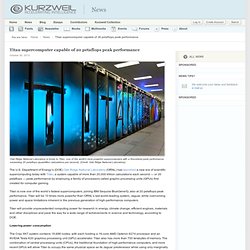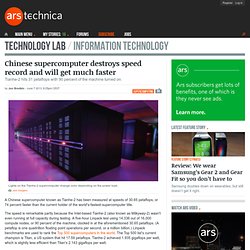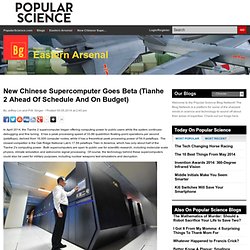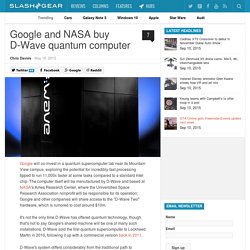

The World's #1 Open Science Supercomputer. Titan's novel architecture alone is no high-performance computing game-changer without applications capable of utilizing its innovative computing environment.

Titan's hardware is only as good as the research that exploits it. Preparing users is a greater challenge than past upgrades to Jaguar due to Titan's architectural evolution. This means researchers must rethink their problems in a way that might be new to their approach. In response, the OLCF has created the Center for Accelerated Application Readiness, or CAAR, a collaboration among application developers, Titan's manufacturer Cray, GPU manufacturer NVIDIA, and the OLCF's scientific computing experts. CAAR has been working for nearly 2 years to establish best practices for code-writers. Titan supercomputer capable of 20 petaflops peak performance.
Oak Ridge National Laboratory is home to Titan, one of the world’s most powerful supercomputers with a theoretical peak performance exceeding 20 petaflops (quadrillion calculations per second).

(Credit: Oak Ridge National Laboratory) The U.S. Department of Energy’s (DOE) Oak Ridge National Laboratory (ORNL) has launched a new era of scientific supercomputing today with Titan, a system capable of more than 20,000 trillion calculations each second — or 20 petaflops — peak performance by employing a family of processors called graphic processing units (GPUs) first created for computer gaming. Titan is now one of the world’s fastest supercomputers, joining IBM Sequoia BlueGene/Q, also at 20 petaflops peak performance. National Center for Supercomputing Applications at the University of Illinois. Chinese supercomputer destroys speed record and will get much faster. A Chinese supercomputer known as Tianhe-2 has been measured at speeds of 30.65 petaflops, or 74 percent faster than the current holder of the world's-fastest-supercomputer title.

The speed is remarkable partly because the Intel-based Tianhe-2 (also known as Milkyway-2) wasn't even running at full capacity during testing. A five-hour Linpack test using 14,336 out of 16,000 compute nodes, or 90 percent of the machine, clocked in at the aforementioned 30.65 petaflops. (A petaflop is one quadrillion floating point operations per second, or a million billion.)
Linpack benchmarks are used to rank the Top 500 supercomputers in the world. The Top 500 list's current champion is Titan, a US system that hit 17.59 petaflops. New Chinese Supercomputer Goes Beta (Tianhe 2 Ahead Of Schedule And On Budget) In April 2014, the Tianhe 2 supercomputer began offering computing power to public users while the system continues debugging and fine tuning.

It has a peak processing speed of 33.86 quadrillion floating-point operations per second (petaflops), derived from 16,000 computer nodes, while it has a theoretical peak processing power of 54.9 petaflops. The closest competitor is the Oak Ridge National Lab's 17.59 petaflops Titan in America, which has only about half of the Tianhe 2's computing power. Both supercomputers are open to public use for scientific research, including molecular scale physics, climate simulation and astronomic signal processing. Of course, the technology behind these supercomputers could also be used for military purposes, including nuclear weapons test simulations and decryption. TOP500 Supercomputing Sites. Brief Introduction. The Green500 List News And Submitted Items. San Diego Supercomputer Center.
La course mondiale aux supercalculateurs. Google and NASA buy D-Wave quantum computer. Google will co-invest in a quantum supercomputer lab near its Mountain View campus, exploring the potential for incredibly-fast processing tipped to run 11,000x faster at some tasks compared to a standard Intel chip.

The computer itself will be manufactured by D-Wave and based at NASA's Ames Research Center, where the Universities Space Research Association nonprofit will be responsible for its operation; Google and other companies will share access to the "D-Wave Two" hardware, which is rumored to cost around $10m. New $1.6 billion supercomputer project will attempt to simulate the human brain. Human Brain Project - Home.
Pleiades Supercomputer. Oak Ridge National Laboratory - ORNL Debuts Titan Supercomputer. ORNL’s John Wagner receives E.O.

Lawrence Award OAK RIDGE, Tenn., April 16, 2014—Oak Ridge National Laboratory researcher John Wagner has been named a 2013 recipient of the Department of Energy’s Ernest Orlando Lawrence Award for his work in advancing computer, information and knowledge sciences. Anasys licenses ORNL nanoscale mass spectrometry imaging technology OAK RIDGE, Tenn., April 14, 2014 – Anasys Instruments Corp. has licensed a Department of Energy Oak Ridge National Laboratory technology that allows for simultaneous chemical and physical characterization and could lead to advances in materials and drug development. ORNL study pegs fuel economy costs of common practices OAK RIDGE, Tenn., April 9, 2014 – People who pack their cars and drive like Clark Griswold in National Lampoon’s “Vacation” pay a steep penalty when it comes to fuel economy, according to a report by the Department of Energy’s Oak Ridge National Laboratory.
ORNL establishes Liane B. Linux powers 91% of the worlds top supercomputers. With the biannual list of the top 500 supercomputers the world over released, the following screenshot of a graph showing the operating systems used in those 500 peta-flop crunching machines, and produced by the University of California Berkeley, makes for an impressive visual glance at Linux’s dominance in Super Computing.

Check it out in its full interactive form @ to get down and dirty with the stats behind it. The HTML5 Supercomputer. Titan1.jpg (Image JPEG, 5034x1791 pixels) - Redimensionnée (25. How to Turn a Jaguar into a Titan. Titan_2012-P03156_3000.jpg (Image JPEG, 3000x1837 pixels) - Redimensionnée (42%) Supercomputing. Inc., The Supercomputer Company. How powerful is a mind? Supercomputer takes 40 minutes to map 1 second of brain activity - Gadgets & Tech - Life & Style. The numbers may not sound too impressive, but this is an important breakthrough in simulation technology and has wide-reaching implications.

Using the K supercomputer, the fourth most powerful in world, scientists in Japan replicated a network of 1.73 billion nerve cells and 10.4 trillion synapses. It took the K computer, with over 700,000 processor cores and 1.4 million GB of RAM, 40 minutes to model the data. The most sophisticated of its kind, the project, a joint venture between Japanese research group RIKEN and German research group Forschungszentrum Jülich, was designed to gauge the limits of brain simulation technology.
RIKEN’s success is the most significant development in the global brain race, wherein the world’s major economies are racing to map the human brain and unlock its secrets. The USA has the BRAIN initiative, the EU has The Human Brain Project, and China has Brainnetome.